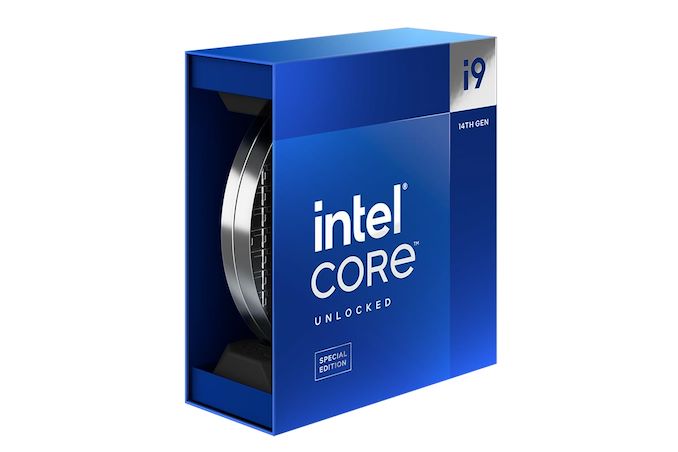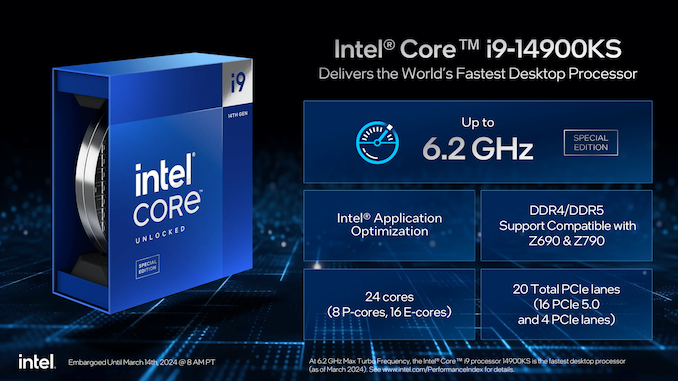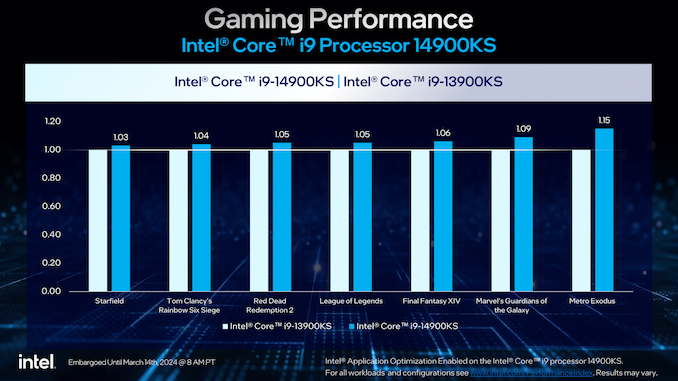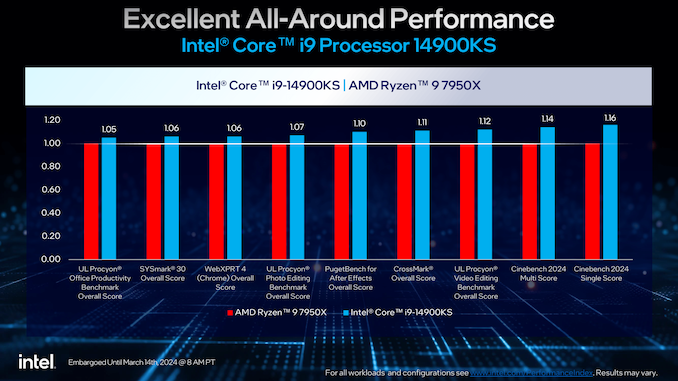Intel Announces Core i9-14900KS: Raptor Lake-R Hits Up To 6.2 GHz
by Gavin Bonshor on March 14, 2024 11:00 AM EST
For the last several generations of desktop processors from Intel, the company has released a higher clocked, special-edition SKU under the KS moniker, which the company positions as their no-holds-barred performance part for that generation. For the 14th Generation Core family, Intel is keeping that tradition alive and well with the announcement of the Core i9-14900KS, which has been eagerly anticipated for months and finally unveiled for launch today. The Intel Core i9-14900KS is a special edition processor with P-Core turbo clock speeds of up to 6.2 GHz, which makes it the fastest desktop processor in the world... at least in terms of advertised frequencies it can achieve.
With their latest KS processor, Intel is looking to further push the envelope on what can be achieved with the company's now venerable Raptor Lake 8+16 silicon. With a further 200 MHz increase in clockspeeds at the top end, Intel is looking to deliver unrivaled desktop performance for enthusiasts. At the same time, as this is the 4th iteration of the "flagship" configuration of the RPL 8+16 die, Intel is looking to squeeze out one more speed boost from the Alder/Raptor family in order to go out on a high note before the entire architecture starts to ride off into the sunset later this year. To get there, Intel will need quite a bit of electricity, and $689 of your savings.
Intel Core i9-14900KS: 6.2 GHz P-Core Turbo for $689
Perhaps the last chip to be launched based on Intel's Raptor Lake architecture, which is built using the Intel 7 process, the Intel Core i9-14900KS, on paper, is certainly no slouch. Building on the capabilities of the flagship Core i9-14900K, the Core i9-14900KS rounds out the Raptor Lake-R family with a P-Core turbo of up to 6.2 GHz, which is 200 MHz more than the P-Core turbo on the Core i9-14900K. It also features a slightly higher E-Core turbo 4.5 GHz, a 100 MHz boost there. Otherwise, the base frequencies for the P-Cores and E-Cores.
Clockspeeds aside, the Core i9-14900KS also has the same core/thread count as the Core i9-14900K. This is an 8P+16E die, capable of supporting up to 32 threads. Everything else, including the 36 MB of L3 cache and the Intel UHD 770 integrated graphics, also remains the same.
As has been the case throughout the lifecycle of the KS processors, arguably the key benefit is that prospective buyers won't need to overclock their processor to achieve these insanely high 6.2 GHz P-core turbo clock speeds; Intel does all of it before it's opened out of the box. This is the best of the best of the silicon that Intel has to offer, at least in terms of clockspeed headroom. As the Core i9-14900K, it sits above the current 14th Gen Core series family stack in terms of clock speeds, but it also replaces it as the fastest out-of-the-box x86 processor ever launched in retail.
These blistering clockspeeds do come at a cost in terms of power, however. Intel has given the Core i9-14900KS a base TDP rating of 150 W, up 25 W compared to the Core i9-14900K. Meanwhile the out-of-the-box PL1/PL2 turbo power limit is 253 Watts, and like the previous i9-13900KS, Intel is once again offering a further "extreme" power profile, which raises those limits to 320 Watts. And even then, enthusiast motherboards can and will violate any and all power limits in the name of keeping clockspeeds high and getting the highest performance possible out of the chip, so the published 253W/320W figures are largely academic.
| Intel 14/13th Gen Core, Raptor Lake-S/R (K/KS/KF Series) Processors | ||||||||||
| AnandTech | Cores P+E/T |
P-Core Base |
P-Core Turbo |
E-Core Base |
E-Core Turbo |
L3 Cache (MB) |
iGPU | Base W |
Turbo W |
Retail Price ($) |
| i9-14900KS | 8+16/32 | 3200 | 6200 | 2400 | 4500 | 36 | 770 | 150 | 253 | $689 |
| i9-14900K | 8+16/32 | 3200 | 6000 | 2400 | 4400 | 36 | 770 | 125 | 253 | $599 |
| i9-14900KF | 8+16/32 | 3200 | 6000 | 2400 | 4400 | 36 | - | 125 | 253 | $574 |
| i9-13900KS | 8+16/32 | 3200 | 6000 | 2400 | 4300 | 36 | 770 | 150 | 253/320 | $640 |
| i9-13900K | 8+16/32 | 3000 | 5800 | 2200 | 4300 | 36 | 770 | 125 | 253 | $537 |
| i7-14700K | 8+12/28 | 3400 | 5600 | 2500 | 4300 | 33 | 770 | 125 | 253 | $419 |
| i7-14700KF | 8+12/28 | 3400 | 5600 | 2500 | 4300 | 33 | - | 125 | 253 | $394 |
| i7-13700K | 8+8/24 | 3400 | 5400 | 2500 | 4200 | 30 | 770 | 125 | 253 | $365 |
| i5-14600K | 6+8/20 | 3500 | 5300 | 2600 | 4000 | 24 | 770 | 125 | 181 | $329 |
| i5-14600KF | 6+8/20 | 3500 | 5300 | 2600 | 4000 | 24 | - | 125 | 181 | $304 |
| i5-13600K | 6+8/20 | 3500 | 5300 | 2600 | 3900 | 24 | 770 | 125 | 181 | $285 |
Case in point: from our review of the first 6.0 GHz processor from Intel, the Core i9-13900KS, we saw a peak power value of around 359 W in our testing. In contrast, when testing the Core i9-14900K with the same power test, we saw a peak power of 375 W, which greatly surpasses the 253 W PL2 limit.
One element to consider is motherboard vendors and their implementations of MCE, which typically push far more power to the chip than Intel puts down in their official specifications to keep their boards ahead of the competition. Fundamentally, the Core i9-14900KS is a 'special binned' version of the regular Core i9-14900K, which means Intel is binning or testing multiple batches of chips that are capable of hitting the 6.2 GHz P-Core turbo clock speeds without running into critical errors. Binning itself is a sort of quality control process to weed out the weaker chips from the more capable silicon, as when chips are fabricated, they aren't all equal to each other in terms of capability.
Perhaps the most important thing to consider with the KS processors, including the latest Core i9-14900KS, is cooling. To get optimal performance, users will need to adopt best-in-class, high-end cooling, such as custom water cooling loops or even Intel's (discontinued) cryogenic adapted coolers. Interestingly, since Intel abandoned the development of their Cryo cooling, EKWB picked up the slack and offers their EK-Quantum Delta TEC D-RGB solution, which should certainly prove better for taming the Core i9-14900KS than a conventional AIO CPU cooler. Using more aggressive cooling methods should prove effective in allowing users to hit the advertised 6.2 GHz core clock speeds for a sustained period of time. It's not easy to keep a processor cool while pulling 375 W, let alone keep it cooled for a prolonged period, so users must consider that.
All of this, in turn, is why the Intel Core i9-14900KS 6.2 GHz P-Core turbo state relies on Intel's Thermal Velocity Boost (TVB) feature; that highest clockspeed doesn't even become available unless there's sufficient thermal headroom for it. Otherwise, users who can't adequately cool the chip for the highest clock speeds are likely to be limited to the true Turbo Boost Max 3.0 frequency of 5.9 GHz, which is just 100MHz higher than the 5.8 GHz limit on the Core i9-14900K and Core i9-14900KF processors.
As Intel hasn't sampled us with the Core i9-14900KS for launch, the company has instead provided some expected performance figures from their own in-house testing. Comparing the latest Core i9-14900KS to the previous KS SKU, the Core i9-13900KS, in gaming performance, Intel has posted modest gains in certain titles, with a 3% gain in performance in Starfield, up to a 15% performance gain in Metro Exodus. Interestingly, Intel's slide deck doesn't compare performance to the current Core i9-14900K, which isn't unexpected. Still, it would have been helpful to see how the extra 200 MHz on the P-Core turbo frequency has an effect on actual real-world performance. It's also worth noting that Intel is using its Application Optimization software to boost these gains, which, in the case of Metro Exodus, actually increases frame rate performance by around 11%, as Intel themselves claim.
In computing performance, Intel compares the Core i9-14900KS directly to AMD's Ryzen 9 7950X and posts performance gains in various workloads and applications. In the UL Procyon Office benchmark, Intel posts gains of 5% over the Ryzen 9 7950X, whereas in CineBench 2024's single-threaded test is claiming gains of 16%, which, given the 6.2 GHz core clock speed, single-threaded workloads are likely to see the biggest benefit to performance.
Looking at motherboard support, the Intel Core i9-14900KS is compatible with both the Z690 and Z790 chipsets, with both DDR5 and DDR4 memory types also being supported. As was the case with the previous-generation i9-13900KS, this is primarily driven by power requirements – KS chips require a lot of power, and non-enthusiast boards are rarely equipped to deliver it, as they're expected to be paired with more mid-range chips. With the increased power requirements of the KS chips, the Z690 and Z790 series motherboards are also a better fit with bigger and more capable power deliveries and more optimal power delivery heatsinks for processors of this calibre.
The Intel Core i9-14900KS is available today at PC component retailers, with Intel setting an MSRP of $689. Interestingly, this is $10 lower than the previous Core i9-13900KS processor at launch, so Intel's flagship desktop CPU is very slowly coming down in price over time. Unfortunately, as with previous iterations of the KS processors, Intel hasn't clarified how many Core i9-14900KS processors will be available to buy or how many they intend to manufacture. However, the Core i9-13900KS is still available to purchase at Amazon even a year later for $640.





_thumb.png)
_thumb.png)
_thumb.png)
_thumb.png)
_thumb.png)
_thumb.png)








30 Comments
View All Comments
ballsystemlord - Thursday, March 14, 2024 - link
A ~3% clock boost is unlikely to scale greater than linearly. Therefore, the performance uplift should be 3% or less compared to their non-KS part. But then that's only the single core turbo. The rest of the time, the chip will perform like i9-14900K. But then the overall performance might be worse because it's blown way past it's thermal limits in the beginning of whatever workload you're doing. ReplyScabies - Thursday, March 14, 2024 - link
The little footnote about Intel Application Optimization might disagree Replyshabby - Thursday, March 14, 2024 - link
The chip will perform faster than the 14900k, reviews are showing its using around 50-100w more during gaming, gains are slim though. ReplySamus - Thursday, March 14, 2024 - link
Exactly. It's a energy penalty that doesn't really pay off unless you demand bleeding edge. ReplyIgor_Kavinski - Thursday, March 14, 2024 - link
Be warned: EK-Quantum Delta TEC D-RGB solution is not meant for all core workloads. From EK's warning on their product page, seems it will simply ensure that the CPU hits 6.2 GHz within the 150W power envelope of the CPU. Replyplsbugmenot - Thursday, March 14, 2024 - link
For short: Intel Announces Core i9-Nonsense with very small performance gains but ridiculous energy consumption for spec sheet fetishists which by everything for any price.Applaus! Reply
Samus - Thursday, March 14, 2024 - link
Intel gotta get their eco-boner on somehow. 30% energy penalty for 3-5% performance. ReplyHresna - Saturday, March 16, 2024 - link
In theory since this is basically a better-binned 14900k, it would also undervolt and/or underclock more efficiently than the stock one. So anyone so inclined could tune it to better efficiency than a stock part. It’s only intel and motherboard manufacturers that push us to burn electronics for the sake of a few % performance…https://www.overclock.net/threads/13900k-power-sca...
But almost nobody paying a premium for this chip is going to intentionally power limit it for 24/7 use, just for a slight PPW spec boost. Reply
Flunk - Saturday, March 16, 2024 - link
Or it's just luck and your 14900k would clock better. There is a lot of random chance when buying CPUs for overclocking. ReplyArtForz - Sunday, March 17, 2024 - link
Even in theory, binning is a lot more complex than that.A few cores clocking really well at stupidly high voltage doesn't preclude being strictly worse than another chip at a more sane point on the VF curve. Reply